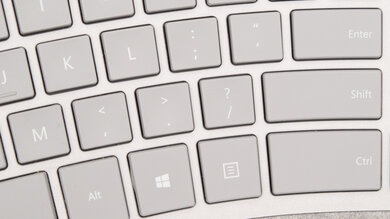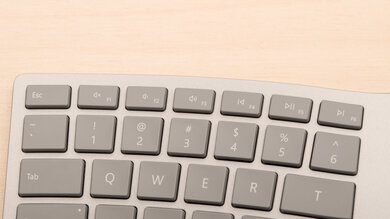The Microsoft Surface Ergonomic Keyboard is an excellent office keyboard designed to promote a natural typing position. It improves on the popular split key cluster design by giving it the same premium material and build quality as other Microsoft Surface products. It's remarkably comfortable to type on. However, features like multi-device pairing, programmable keys, and backlighting are noticeably absent. The keyboard layout requires some adaptation, but if you're willing to give it a try, it may be beneficial in the long run.
Our Verdict
The Microsoft Surface Ergonomic Keyboard is mediocre for gaming. The keyboard is comfortable to use and the switches' low pre-travel distance feels very responsive. However, it doesn't have programmable keys or backlighting, and its Bluetooth latency may not be suitable for fast-paced games, though this isn't something we currently test for. It also lacks dedicated macro keys for MMO games and there's no software for customization either.
-
Exceptional build quality.
-
Excellent ergonomics.
-
Great typing experience.
-
No software for customization.
-
Uses disposable batteries.
-
No backlighting.
The Microsoft Surface Ergonomic Keyboard is excellent for office use. Its ergonomic design is very comfortable to type on and doesn't cause any fatigue. It's suitable for nearly any office environment due to its very quiet typing noise, and it has an outstanding build quality that should last for years. It can be used with any computer that has a Bluetooth connection; however, some keys don't work on macOS and Linux.
-
Exceptional build quality.
-
Excellent ergonomics.
-
Great typing experience.
-
No software for customization.
-
Uses disposable batteries.
-
No backlighting.
The Surface Ergonomic Keyboard isn't recommended for use with mobile devices. It can be paired with any device that has Bluetooth capabilities, but due to its sheer size and weight, it's very difficult to carry around. Furthermore, most shortcuts don't work on mobile operating systems.
-
Exceptional build quality.
-
Excellent ergonomics.
-
Great typing experience.
-
No software for customization.
-
Uses disposable batteries.
-
No backlighting.
The Microsoft Surface Ergonomic Keyboard is passable for programming. The keyboard's ergonomic design lets you work long hours without fatigue, and the keys feel great to type on. Unfortunately, it doesn't have programmable keys or a multi-device pairing feature for multitasking. On the upside, it has great compatibility with most operating systems, though some shortcuts don't work on macOS and Linux.
-
Exceptional build quality.
-
Excellent ergonomics.
-
Great typing experience.
-
No software for customization.
-
Uses disposable batteries.
-
No backlighting.
-
Exceptional build quality.
-
Excellent ergonomics.
-
Great typing experience.
-
No software for customization.
-
Uses disposable batteries.
-
No backlighting.
-
Exceptional build quality.
-
Excellent ergonomics.
-
Great typing experience.
-
No software for customization.
-
Uses disposable batteries.
-
No backlighting.
- 5.8 Gaming
- 8.0 Office
- 5.7 Mobile/Tablet
- 7.4 Programming
- 4.1 Entertainment / HTPC
- 5.7 Raw Performance
Changelog
- Updated Nov 29, 2023: We've converted this review to Test Bench 1.3.1, which adds a new estimated PCB latency test to the Single-Key Latency section and a new Analog test to the Switches section of this review. You can see the full changelog here.
- Updated Oct 30, 2023: We've converted this review to Test Bench 1.3, which overhauls how key input is evaluated. We've added new tests for Single Key Latency, Multi Key Latency, Data Transmission, and Chord Split. We've also introduced a new Raw Performance usage and adjusted how the Gaming and Office usage scores are calculated. You can see the full changelog here.
- Updated Jun 21, 2023: We've converted this review to Test Bench 1.2. This update introduces new Backlight Features and Backlight Clarity test boxes. We've also added a new Switches test box, added additional test comparisons to our Hardware Customizability test box that we introduced with our last Test Bench. For an in-depth look at our changes, you can see our full changelog here.
- Updated May 31, 2023: We've converted this review to Test Bench 1.1. This update adds several new tests addressing Hardware Customization, Macro Keys And Programming, and Wireless Mobile Compatibility. We've also added new objective evaluations to the Typing Noise test, and we've simplified several tests and removed several others that were no longer relevant. For an in-depth look at all our changes, you can see our full changelog here.
- Updated Apr 21, 2021: Fixed error with minimum incline.
Check Price
Compared To Other Keyboards
The Surface Ergonomic Keyboard is an excellent office keyboard designed for anyone who might be concerned about repetitive strain injuries. Its split key cluster design isn't new, as there are many similar keyboards on the market, and it lacks features such as multi-device pairing when compared to a keyboard like the Logitech ERGO K860. However, its clean and modern design is very pleasing, and the Alcantara-covered wrist rest is a unique signature of Microsoft's Surface product line.
For other options, you can see our recommendations for the best keyboards, the best keyboards for writers, and the best wireless keyboards.
The Logitech ERGO K860 is better than the Microsoft Surface Ergonomic Keyboard for most uses. The Logitech has reverse incline settings to prevent the wrists from bending downwards and has better wireless capabilities, as it can be paired to multiple devices at the same time with its USB receiver and through Bluetooth. The Logitech also has software support, but the Surface Ergonomic has a much better build quality.
The Kinesis Freestyle Pro is a bit better than the Microsoft Surface Ergonomic Keyboard. The Freestyle Pro's split keyboard design lets you place the two halves any way you want, but the Surface Ergonomic is more comfortable due to its great Alcantara wrist rest. The Freestyle Pro has mechanical Cherry MX Brown switches, programmable keys, and software support; however, the Surface Ergonomic has significantly better build quality.
The Microsoft Surface Ergonomic Keyboard is significantly better than the Matias Ergo Pro. Although they have very different approaches to the split keyboard design, the Microsoft is better in almost all aspects, such as build quality, ergonomics, and versatility, since it can be paired to anything that has a Bluetooth connection. However, the Matias has better compatibility with Linux.
The Microsoft Surface Ergonomic Keyboard is much better than the Adesso Tru-Form 150. The Microsoft has a much better build quality, typing quality, and compatibility with different operating systems. The Microsoft's Bluetooth connection also makes it more versatile, but it doesn't have backlighting, which the Adesso has.
The Microsoft Surface Ergonomic Keyboard is a better ergonomic keyboard than the Kensington Pro Fit Ergo Wireless Keyboard. The Microsoft is noticeably better-built and feels more durable. However, it doesn't have any feet to create a negative incline as the Kensington does. On the other hand, the Surface Ergonomic Keyboard offers a noticeably better typing experience thanks to its more stable keys.
The Microsoft Surface Ergonomic Keyboard is a better keyboard than the Microsoft Bluetooth Keyboard. It's noticeably better built, has better ergonomics, and offers a better typing quality, but it might take you a bit of time to get used to the split-key layout. On the other hand, if you're just looking for a straightforward wireless board, the Microsoft Bluetooth Keyboard might be a better option.
Test Results
Build quality is exceptional. Like the Surface Keyboard, it has an aluminum frame, though it feels slightly heavier and it has a little bit of flex. The keycaps feel smooth and the keys are very stable. The wrist rest is covered with Alcantara, a durable fabric most often used in luxury cars and a regular feature of Microsoft's Surface lineup.
This keyboard has outstanding ergonomics. It has a 'dome-like' design with separate key clusters that aims to promote a more natural alignment of the wrists and forearms when typing. Unlike the Microsoft Sculpt Ergonomic Keyboard, it doesn't have any incline settings and is meant to lay flat on the table. The wrist rest is built-in, and it's covered with Alcantara, a suede-like synthetic fabric. If you prefer a true split keyboard design that allows you to adjust the two halves independently, check out the Dygma Raise.
The Surface Ergonomic Keyboard doesn't have backlighting.
This keyboard uses disposable batteries and can't be used wired.
This keyboard can only be used through a Bluetooth connection and it uses disposable batteries.
The Surface Ergonomic Keyboard has very few extra features. There are media control hotkeys that are shared with function keys, and a few shortcuts such as calculator, notifications, search, and task view.
Typing experience on this keyboard is great. Although it has a high actuation force to get over the tactile bump, the overall feeling is light and doesn't cause any fatigue. It does take some time to get used to the keyboard's layout, so you may make a few more typos at first. It feels like a mix of the Microsoft Surface Keyboard and the Logitech ERGO K860.
This keyboard's typing noise is extremely quiet and very unlikely to disrupt those around you.
The Surface Ergonomic Keyboard uses scissor switches that are identical to the Surface Keyboard. They require a bit of force to get over the tactile bump, but the overall feeling is still fairly light. Their pre-travel distance is very short, making them feel very responsive.
The Surface Ergonomic Keyboard doesn't have customization software.
On Windows, all default keys work. On macOS, the F11 minimizes your window, the Insert key acts as a Help key, and the Menu and Calculator keys do nothing. The Scroll Lock and Pause/Break keys also adjust screen brightness if you're using an Apple display. On Linux, the Screen Brightness, Search, and Settings keys do nothing.
On Android devices, the Settings (F12) and Lock keys don't work. Also, the F9 Hotkey registers as an Alt key, and the F10 key registers as Tab.
On iOS devices, the Messages, Settings, Lock, Search, and Insert keys don't work. Also, the F4, F8, F9, and F10 hotkey actions don't work.
On iPadOS, the Messages, Settings, Lock, Search, Insert, and Emogi keys don't work.































